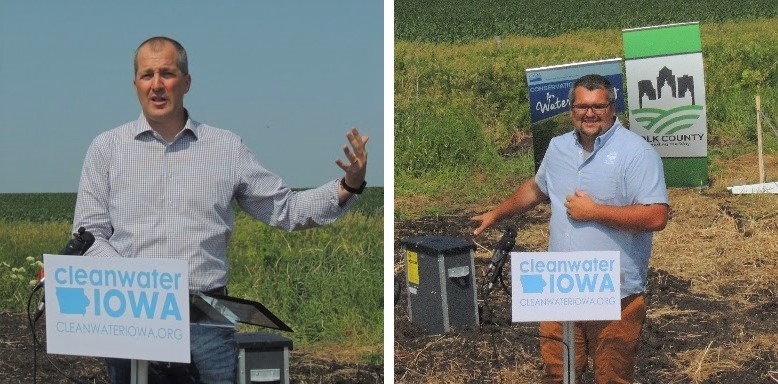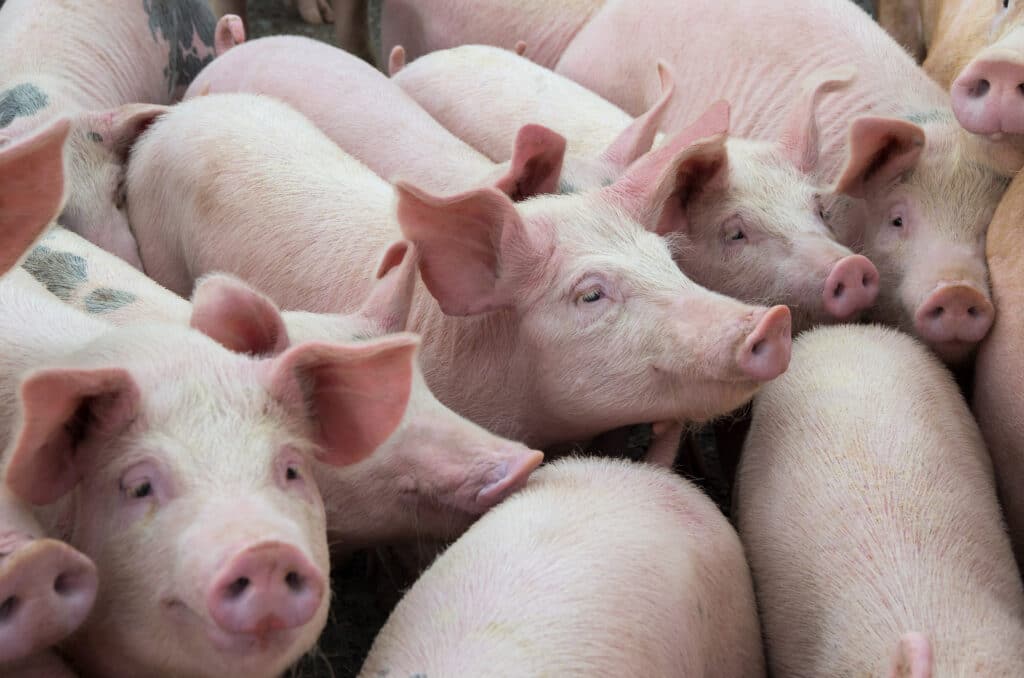Project to clean up central Iowa watersheds unveiled at northern Polk County farm

MICHAEL CRUMB Jun 18, 2021 | 4:55 pm
5 min read time
1,204 wordsAll Latest News, Energy, Government Policy and LawIowa Secretary of Agriculture Mike Naig, left, and John Swanson, right, Watershed Management Authority coordinator with Polk County Public Works, talk about the Central Iowa Water Quality Infrastructure Project during an event Thursday at the Kurt Lehman farm north of Alleman. Photos by Michael Crumb
While strides have been made in reducing soil erosion and the loss of phosphorus from the state’s farmland, more needs to be done to reduce the amount of nitrogen flowing from Iowa farm fields into the state’s waterways, Iowa Secretary of Agriculture Mike Naig said Thursday during an event to kick off the Central Iowa Water Quality Infrastructure Project.
Naig was joined by various conservation, drainage and watershed management leaders for the event, held on the Kurt Lehman farm just north of Alleman in northern Polk County.
They touted the benefits of the project, which creates a framework to streamline and ramp up the use of saturated buffers and bioreactors on the edge of farm fields in Polk and Dallas counties by simplifying the financial and construction processes for property owners.
A saturated buffer diverts the flow of runoff from existing drainage tiles so water passes through subsurface soils and vegetation, filtering it before it enters a creek or stream. The average cost of building a saturated buffer is about $4,000.
According to the project website, 40 saturated buffers and 11 bioreactors will be added to farm fields during the first phase of the project to protect water quality and support recreation on the Des Moines and Raccoon rivers. The first phase is expected to be complete by mid-2022. The second phase has grown in size and is now expected to include another 150 sites and additional counties.
The estimated cost for phase one is $400,000, with the Iowa Department of Agriculture and Land Stewardship funding 75% of the construction costs, and Polk County is funding 25% percent of the construction costs. The costs for phase two were not available.
With a saturated buffer and Fourmile Creek as the backdrop, Naig said aggressive goals were set for phosphorus retention and nitrogen reduction in the state’s Nutrient Reduction Strategy.
“Over the past several decades we’ve made progress in reducing phosphorus loss, but we need to double down on nitrogen,” he said. “This project creates a model that allows us to speed up the pace that we’re adding those practices across the state, and this project … is impacting the residents of Polk and Dallas counties and our neighbors downstream. Other communities are watching what’s happening here, and we know success here will lead to successful projects elsewhere.”
Jon Hubbert, state conservationist for the U.S. Department of Agriculture’s Natural Resources Conservation Service, said the project will help farmers reach their conservation goals.
“The producers want to do the right thing, and this helps them to do that without too many impacts on their operations,” he said.
John Norwood, Polk County Soil and Water Conservation District commissioner, said the state’s agricultural system is unbalanced and unsustainable, and too focused on commodity production.
“Meanwhile our soils are being depleted at 10 times the rate Mother Nature provides and our drinking water, flood control reservoirs and local infrastructure … is fouled all the way to the gulf with sediment and excess nutrients,” he said.
Nutrient runoff from farm fields is considered to be among the leading causes of a growing area in the Gulf of Mexico known as the dead zone, an area of water where oxygen levels are too low to support marine life. It’s caused every year by nitrogen and phosphorus pollution that flows into the gulf from the Mississippi River.
Norwood asked what would happen if the state adopted a new vision that is “productive, resilient, regenerative, diverse, vibrant and balanced using agricultural productivity, water management, water sovereignty, soil health and biological activities as principal measures for success.”
“What is missing?” he said. “We start with a call for action.”
Norwood said the state is up to the difficult water and soil challenges it faces.
“The challenge is one I believe Iowa farmers and Iowans are willing to accept and ones that now need to be faced,” he said.
Under the plan, sophisticated mapping tools that look at topography, stream bank height and soil types will identify project sites that will have the biggest impact on water quality. There will also be concerted efforts to reach out to farmers and landowners along Fourmile, Mud, Camp, Spring and Walnut creeks to encourage them to participate.
It also works to create a simplified funding structure and temporary construction easement payment, making it easier for landowners to participate.
A key element of the plan is “identifying multiple edge-of-field practice sites in one county to make it easier and more attractive for contractors to bid on the project, reducing the overall project costs,” the project’s website stated.
John Swanson, Watershed Management Authority coordinator with the Polk County Public Works Department, said he knows it may be a hard sell for some landowners who have been listening to water improvement arguments for decades.
“With this project, we tried to come up with a new pitch and say we want to work with you, we’ve hit all those hurdles in the past five years, let’s change things up, and that’s got us to where we are today, bringing a strong team together. And at the end of the day we’re ready to ramp it up,” he said.
Funding partners involved in the project include the Iowa Department of Agriculture and Land Stewardship, Polk County, USDA-NRCS, the city of Des Moines, the Agricultural Drainage Management Coalition and the Polk Soil and Water Conservation District.
Water improvement efforts also received a boost this year from the Legislature, which approved a 10-year extension of the state’s Water Quality Fund, adding $329 million for water quality efforts through 2039, Naig said.
In comments made to the Business Record after the event, Naig said efforts to clean up the state’s waterways through edge-of-field practices like saturated buffers and wetlands will be a long-term venture.
“We’ve got a long history of conservation in Iowa as it relates to preventing soil erosion, and that’s taken us decades to get to where we want to be with that,” he said. “We need to apply the same kind of focus to addressing nitrogen. This is really one of those first projects where we see a coordinated effort, in a targeted area in this particular watershed, and when you start to get to that kind of scale in a smaller watershed you can see impact in the water. This is reducing the amount of nitrate flowing in the stream, and that has an impact downstream.”
He said the program will have to expand to more property owners and communities statewide for its true impact to be seen.
“It’s going to take us a lot of time and resources, but that’s what we’re all focused on right now, how do we accelerate and get more done in focused areas like this,” Naig said. “When you see change on the land, you’ll see the change in the water you want to see.”
Watch a short video of Mike Naig talking about the Central Iowa Water Quality Infrastructure Project.










